Posted by: Skin And Cancer Institute in Cosmetic Procedures
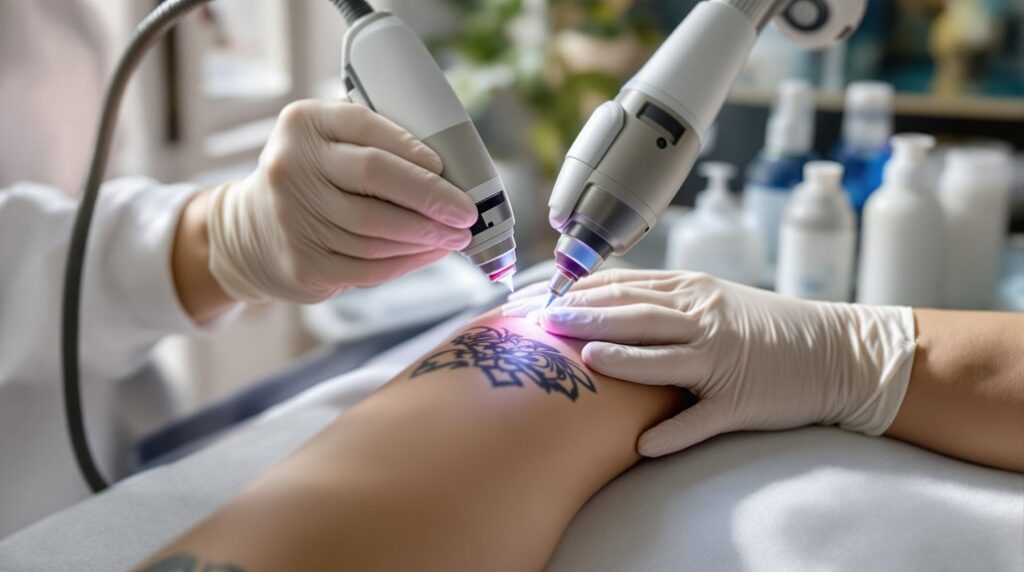
California dermatologists provide safe tattoo removal using advanced laser technologies that target specific ink pigments without damaging surrounding tissue. We’ll evaluate your tattoo’s ink composition, age, and location while following strict state regulations for sterilization and patient safety. Multiple sessions spaced 6-8 weeks apart are typically needed as your immune system gradually clears fragmented ink particles. Proper aftercare between treatments enhances results and minimizes risks like scarring or pigmentation changes. Our thorough approach ensures ideal outcomes.
Key Takeaways
- California law requires specialized practitioner training on ink composition, laser interactions, and potential complications like hyperpigmentation and scarring.
- Multiple laser technologies (PicoSure, Q-Switched) target different ink colors with varying wavelengths to fragment tattoo particles for immune system removal.
- Success factors include ink color (black/red remove easier), skin tone (fair skin shows better results), and tattoo age (older ones respond better).
- Typical treatment requires 6-12 sessions spaced 6-8 weeks apart, with costs ranging from $200-500 per session.
- Post-treatment care involves keeping the area clean, applying antibiotics, using SPF 30+ sun protection, and avoiding swimming for 48 hours.
The Science Behind Modern Tattoo Removal Technologies
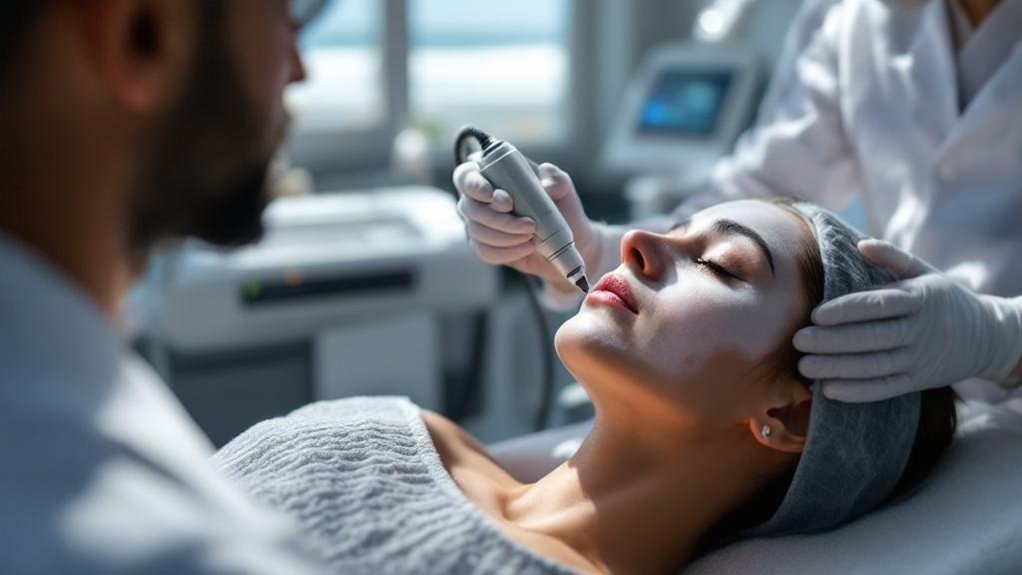
How do modern tattoo removal technologies actually work?
At our practice, we utilize laser systems that target specific chemical pigments within the skin. These lasers deliver ultra-short pulses of energy that shatter tattoo ink composition into tiny particles without damaging surrounding tissue.
Different wavelengths target various ink colors—red pigments respond to green light, while black and blue pigments react to near-infrared wavelengths. When the laser breaks down these particles, your immune system gradually removes them from your body.
Modern techniques require fewer sessions with improved results compared to older methods. Understanding the interaction between lasers and various tattoo ink composition types helps us customize treatment plans for each patient. We’re committed to providing the most effective removal options while minimizing discomfort and recovery time. Our specialists develop individualized treatment plans for tattoo removal just as we do for our skin cancer patients.
California’s Regulatory Standards for Removal Procedures
California maintains some of the strictest regulatory frameworks for tattoo removal in the nation, which practitioners in our field must thoroughly understand. As dermatologists, we’re required to complete specialized training that includes knowledge of tattoo ink composition and its interaction with laser technologies. State law mandates that we explain the skin healing process to patients, including potential complications like hyperpigmentation and scarring. All facilities must maintain specific sterilization protocols and proper ventilation for ink particle evacuation during procedures.
We’re also obligated to document pre-existing skin conditions that might affect removal outcomes. For our patients, these regulations assure safer procedures with standardized care.
When you choose a licensed California dermatology practice for tattoo removal, you’re benefiting from these protective measures designed to optimize results while minimizing health risks. Our board-certified dermatologists at The Skin and Cancer Institute provide comprehensive care using advanced techniques for all dermatological procedures.
Evaluating Your Tattoo: Factors That Affect Removal Success
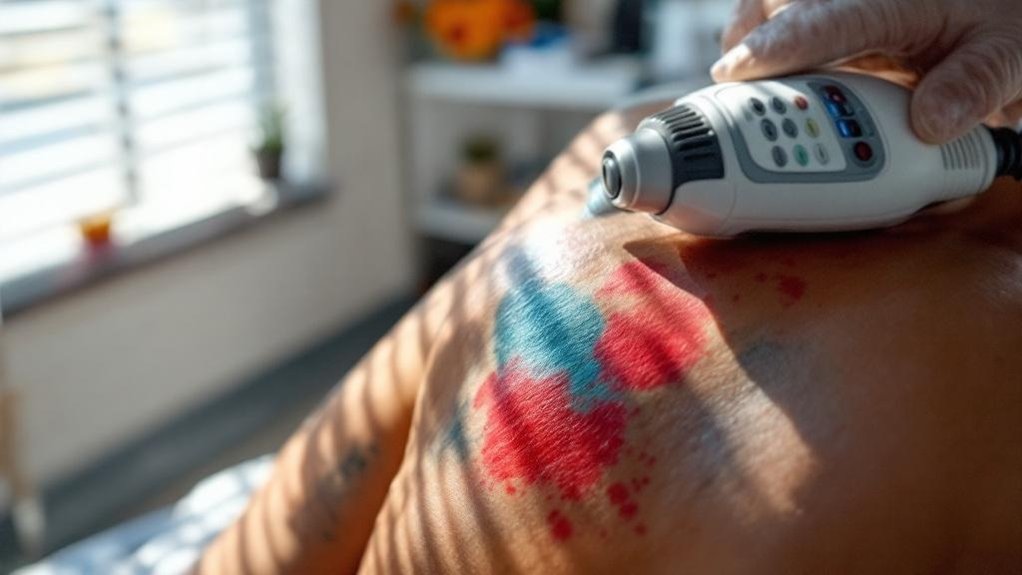
At our Skin and Cancer Institute, we recognize that ink type considerably impacts tattoo removal success, with black and red pigments typically responding better to laser treatments than blues and greens.
We’ve observed that patients with fair skin often experience more complete removal outcomes, as the greater contrast between skin and tattoo pigment allows lasers to target ink more precisely.
Your skin tone and ink colors will inform our personalized treatment approach, helping us establish realistic expectations for your removal journey.
For patients concerned about scarring, we offer non-surgical treatments that focus on improving skin condition while effectively removing unwanted tattoos.
Ink Type Matters
The composition of your tattoo ink considerably influences the success of any removal procedure we undertake. Professional-grade black and red inks typically respond best to laser treatments, while greens, blues, and fluorescent colors present greater challenges.
At our dermatology practice, we assess ink composition during your initial consultation to set realistic expectations. Amateur or homemade tattoos often contain simpler ink compositions and typically require fewer treatment sessions than professional work. Temporary tattoo residue may seem persistent but generally responds well to our specialized approaches.
We’ve found that older tattoos with partially faded ink generally respond more favorably than fresh tattoos with dense pigmentation. As California’s leading dermatology team, we customize removal protocols based on your specific ink type to maximize effectiveness while minimizing potential side effects and recovery time.
Skin Tone Considerations
Your natural skin tone plays a crucial role in determining both the approach and efficacy of tattoo removal procedures. At the Skin and Cancer Institute, we recognize that darker skin pigmentation requires specialized treatment protocols to prevent hypopigmentation or hyperpigmentation.
Patients with melanin-rich skin often need lower laser energy settings and more sessions spaced further apart to achieve ideal results without damaging surrounding tissue. We’re careful to assess the potential for post-inflammatory pigmentation changes, which occur more frequently in darker skin tones.
We also respect the cultural significance tattoos may hold for many of our patients. This understanding informs our treatment recommendations and expectations for removal outcomes.
Before beginning any procedure, we’ll conduct a thorough evaluation of your skin type using the Fitzpatrick scale to create a personalized removal plan.
Finding a Board-Certified Dermatologist in California
When seeking tattoo removal services in California, selecting a board-certified dermatologist should be your top priority.
Board certification guarantees your provider has specialized training in treating various skin conditions, understanding tattoo ink composition, and managing skin healing factors.
We recommend researching dermatologists who specifically mention laser tattoo removal among their services. Check their credentials through the American Board of Dermatology website and read patient reviews focusing on tattoo removal outcomes.
Many qualified dermatologists practice throughout California, particularly in metropolitan areas like Los Angeles, San Francisco, and San Diego. Schedule consultations with at least two specialists before proceeding with treatment.
During these appointments, ask about their experience with your skin type and the specific colors in your tattoo, as these factors considerably impact removal success. For those unable to find suitable providers in California, The Skin and Cancer Institute offers cosmetic procedures that include various skin treatments tailored to individual patient needs.
Laser Removal Options: From PicoSure to Q-Switched
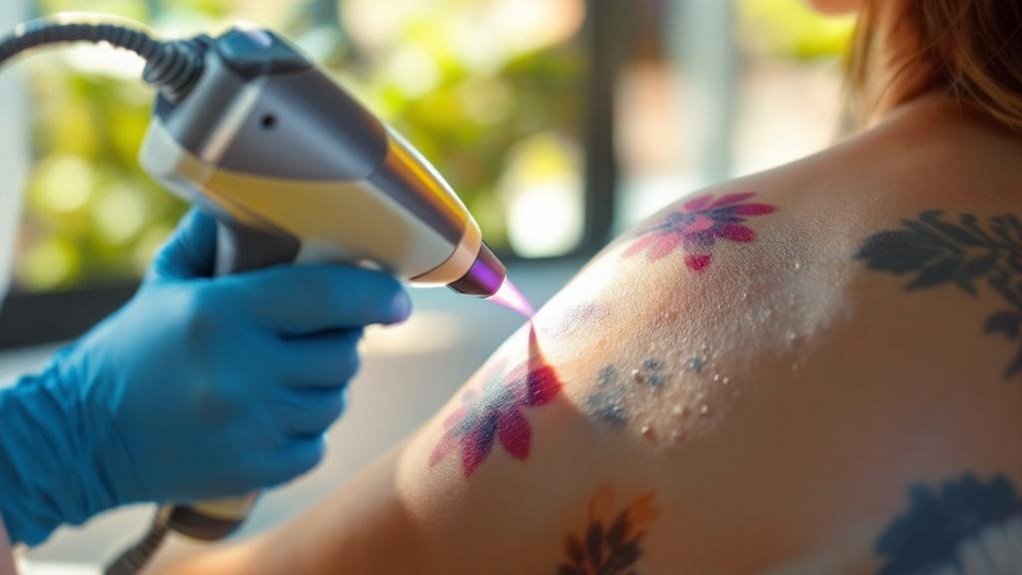
After identifying a qualified dermatologist for your procedure, understanding available laser technologies becomes the next step in your tattoo removal journey. At the forefront are two primary systems: PicoSure and Q-Switched lasers, each offering distinct advantages based on tattoo ink composition and color.
PicoSure technology delivers ultra-short pulses measured in picoseconds, effectively shattering ink particles into microscopic fragments that your body can more readily eliminate. Q-Switched lasers, while using nanosecond pulses, remain highly effective for certain ink colors, particularly dark pigments.
We consider several factors when recommending the appropriate laser, including your skin type, ink colors present, and anticipated skin healing process. Multiple sessions are typically required as your immune system gradually clears the fragmented ink particles. The ideal approach often combines technologies for best results.
What to Expect During Your Initial Consultation
During your initial tattoo removal consultation, we’ll evaluate your complete medical history to identify any conditions that might affect treatment outcomes.
We’ll thoroughly explore available removal options, considering factors such as your tattoo’s age, ink colors, and location to determine the most effective approach.
Our dermatologists will establish a realistic timeline for your removal process, explaining the expected number of sessions and intervals between treatments based on your specific circumstances.
Our board-certified dermatologists at The Skin and Cancer Institute provide personalized care while ensuring Medicare coverage for eligible procedures.
Medical History Assessment
A thorough medical history assessment forms the foundation of any safe tattoo removal treatment plan. During your consultation, we’ll discuss your complete health profile, including any medications, allergies, immune disorders, or skin conditions that might affect treatment outcomes.
We’ll evaluate the tattoo ink composition, as different pigments respond variably to laser treatments. This analysis helps us determine the most effective removal protocol while minimizing potential side effects.
We’ll also review previous removal attempts, if any, and discuss realistic expectations.
It’s essential to disclose pregnancy, breastfeeding status, history of keloids, hyperpigmentation, or hypopigmentation. These factors markedly influence treatment safety and efficacy.
Our dermatologists use this extensive assessment to create a personalized removal plan that prioritizes your skin’s health while achieving ideal results.
Treatment Options Exploration
When you schedule an initial consultation at the Skin and Cancer Institute, we’ll guide you through an extensive exploration of available tattoo removal techniques.
Our dermatologists will analyze your tattoo ink composition to determine the most effective treatment approach, as different pigments respond to various wavelengths of laser energy.
We’ll discuss laser options including Q-switched, picosecond, and combination therapies, explaining how each works to break down ink particles for natural elimination through your body’s lymphatic system.
Understanding your skin healing process is vital for developing a personalized plan that minimizes scarring and optimizes results.
We’ll provide realistic timelines based on tattoo size, color, depth, and location.
Our expertise allows us to address concerns about pain management, recovery periods, and potential side effects, ensuring you feel confident about your treatment journey.
Realistic Timeline Planning
Setting realistic expectations represents the foundation of successful tattoo removal. During your initial consultation, we’ll assess your tattoo’s age, size, ink composition, and location to create a personalized treatment plan. Most patients require 6-12 sessions spaced 6-8 weeks apart to allow for proper skin healing processes between treatments.
Professional tattoos with multiple colors typically take longer to remove than amateur ones. Black and red inks generally respond more quickly than blues and greens. We’ll discuss how your skin type affects treatment outcomes and healing times.
Remember that complete removal isn’t always possible for every tattoo. We’re committed to developing a timeline that balances your goals with biological realities, ensuring you understand each step of your tattoo removal journey.
The Removal Process: Timeline and Multiple Sessions
Unlike simpler cosmetic procedures, tattoo removal isn’t accomplished in a single visit. Most patients require between 5-12 sessions spaced 6-8 weeks apart, allowing your skin to heal properly between treatments.
The timeline varies based on several factors including tattoo ink composition, color intensity, and skin elasticity. Professional tattoo inks often require more sessions than amateur tattoos, while black ink typically responds faster than colored pigments—particularly blues and greens which prove most stubborn.
We customize each removal plan based on your specific tattoo characteristics and healing response. During your consultation at Skin and Cancer Institute, we’ll provide a realistic timeline projection, helping you understand what to expect throughout your removal journey.
Remember that patience yields the best results with minimal scarring. Our board-certified dermatologists will ensure you receive the highest quality care throughout the tattoo removal process.
Managing Pain and Aftercare Between Treatments

Though tattoo removal is generally well-tolerated, proper pain management and aftercare are essential for ideal results and comfort. At the Skin and Cancer Institute, we recommend ice application before and after treatments to minimize discomfort. Some patients benefit from topical anesthetics, which we can discuss during your consultation.
Aftercare routines between sessions are vital for best healing. We advise keeping the area clean, applying prescribed antibiotic ointment, and protecting treated skin from sun exposure with SPF 30+.
Avoid swimming pools, hot tubs, and strenuous exercise for at least 48 hours post-treatment. Most importantly, don’t pick at blisters or scabs that may form. This can lead to scarring or infection.
We’re always available to address concerns that arise during your healing process between appointments. Our board-certified dermatologists at the Pahrump, NV location provide personalized treatment plans to ensure optimal healing between tattoo removal sessions.
Cost Considerations and Insurance Coverage in California
When considering tattoo removal treatments, financial planning is just as important as physical preparation. At Skin and Cancer Institute, we recognize that cost is a significant factor in your decision-making process.
In California, tattoo removal typically ranges from $200-500 per session, with most patients requiring 5-10 treatments for complete tattoo ink dispersal. Unfortunately, insurance rarely covers tattoo removal as it’s considered cosmetic. However, some cases involving traumatic injuries may qualify for coverage.
We recommend patients verify our dermatological licensing credentials and inquire about payment plans before beginning treatment. Many of our offices offer financing options to make these procedures more accessible.
During your consultation, we’ll provide a personalized estimate based on the tattoo’s size, age, color composition, and location—allowing you to budget appropriately for your treatment journey. Our board-certified dermatologists perform tattoo removal using non-invasive methods to maximize your comfort during the procedure.
Alternative Removal Methods When Lasers Aren’t Suitable
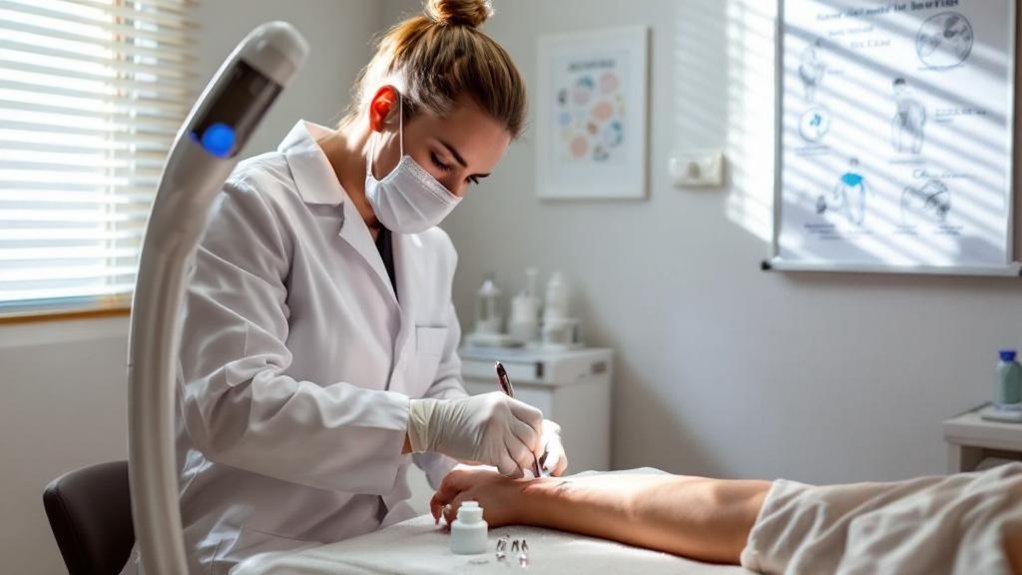
While laser treatments remain the gold standard for tattoo removal, certain skin conditions, tattoo compositions, or medical histories may contraindicate their use.
At Skin and Cancer Institute, we recognize that alternative approaches may be necessary for some patients.
Despite common tattoo removal myths, surgical excision can effectively remove smaller tattoos when lasers aren’t viable. This procedure involves cutting out the tattooed skin and closing the wound with sutures.
For larger tattoos, dermabrasion or chemical peels may gradually fade ink, though results vary considerably.
We caution against unproven alternative therapies such as salt scrubbing or lemon juice applications, which can damage skin without effectively removing tattoos.
Instead, we recommend professional consultation to determine appropriate options based on your specific circumstances, tattoo characteristics, and skin type.
Our board-certified dermatologists offer expert evaluation to help you navigate all available tattoo removal options safely and effectively.
Frequently Asked Questions
Can I Get a Tattoo Removed While Pregnant or Breastfeeding?
We don’t recommend tattoo removal during pregnancy or breastfeeding. Tattoo removal safety concerns for pregnant women include potential risks to fetal development from laser treatments and medications.
How Do Tattoo Colors Affect Removal Success Rates?
Different ink compositions affect removal difficulty markedly. Black and red typically respond best, while yellows and greens show greater color longevity. We’ll assess your tattoo’s specific color profile during consultation.
Will Tattoo Removal Leave Scars on My Skin?
While scarring is possible, our advanced laser techniques minimize this risk. We’ll monitor your skin healing carefully throughout the process. Most patients experience minimal to no permanent scarring with proper aftercare.
Can I Exercise Immediately After a Tattoo Removal Session?
We don’t recommend exercising immediately after tattoo removal. As part of proper post-treatment care, we advise waiting 24-48 hours to allow initial healing time and minimize potential complications.
Are There Specific Tattoo Inks That Are Easier to Remove?
Yes, black and red tattoo ink compositions are generally easier to remove than bright colors. Blues and greens have more complex ink composition that often requires additional laser sessions for complete removal.
Conclusion
We’ve guided you through the essentials of medical tattoo removal in California, where regulations, technology, and practitioner expertise considerably impact outcomes. Remember, safe removal requires a board-certified dermatologist’s care, multiple sessions, and appropriate aftercare. At our institute, we’re committed to providing personalized treatment plans using advanced laser technologies. Don’t hesitate to schedule a consultation to discuss your specific tattoo removal needs.